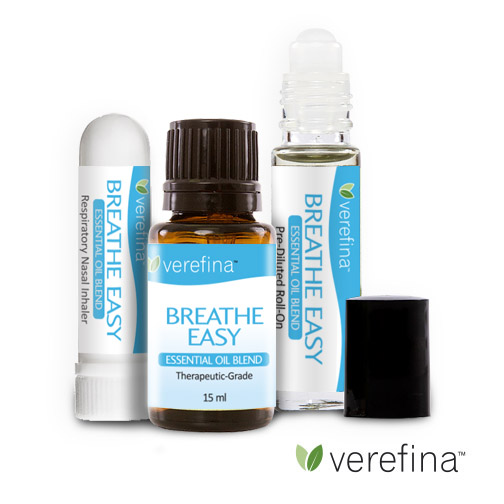Beneficial Ingredients in Breathe Easy Keep Respiratory Symptoms Under Control
Posted by Katie Zapotoczny on 10th May 2016

It’s no secret that great ingredients make great products. There’s no doubt that this is true of Verefina’s newest product line: Breathe Easy. Made with carefully selected therapeutic-grade essential oils that are known for their ability to break up congestion and support healthy respiratory function, Breathe Easy can help provide relief for allergy-, asthma-, and cold-sufferers alike. This product contains eucalyptus, peppermint, lemon, tea tree, lavender, ravintsara, and bay leaf essential oils, all of which can help ease the symptoms of various respiratory conditions.
Eucalyptus
Breathe Easy actually contains two species of eucalyptus: eucalyptus globulus and eucalyptus radiata. Both are high in a compound called 1,8 cineole. This compound has a number of properties that make eucalyptus oil (and other Breathe Easy ingredients) particularly effective for helping the body to cope with respiratory illnesses and conditions. Cineole 1,8 has the following properties (to name a few):
- Airborne antimicrobial
- Antibacterial
- Inflammation reduction
- Antiviral
- Expectorant
- Cough suppressant (source)
The high 1,8 cineole content in eucalyptus oil allows it to help rid the air of microbes when it is put in a diffuser. As an expectorant, eucalyptus can help loosen phlegm. Putting several drops of the essential oil in a diffuser and breathing in the mist is especially helpful for breaking up congestion in the respiratory passages. Eucalyptus can also help flush out toxins and microorganisms that cause illness (source). And, finally, this is oil helps dilate blood vessels, allowing more oxygen into the lungs; for this reason it is useful for relieving symptoms related to asthma, bronchitis, COPD, and pneumonia (source).
Peppermint
Like eucalyptus, peppermint essential oil acts as an expectorant and is useful for helping to clear clogged and congested sinuses (source). Peppermint oil can also help rid the body of irritants that stimulate allergies. As a natural muscle relaxant, it can help relax the muscles in nasal passages, making it easier to release mucous and pollen (source). Peppermint constricts capillaries, creating a cooling sensation. It can therefore help bring a fever down during illness (source). Peppermint’s antimicrobial, antioxidant, and decongestant properties also make it useful for easing the pain of a sore throat (source).
Lemon
Lemon essential oil is a natural detoxifier and has antibacterial and inflammation reduction properties. It is high in vitamin C and stimulates salivation, keeping the throat moist. All of these properties make lemon essential oil useful for treating sore throats (source). Lemon oil’s high vitamin C content supports immune function and boosts the body’s production of white blood cells (source).
Tea Tree
Derived from the tea tree plant (Melaleuca alternifolia), which is native to Australia, tea tree oil has a range of medicinal uses. It contains volatile oils known as terpenes that can destroy bacteria (source). Tea tree oil can also help loosen chest and head congestion and a stuffy nose, especially when used in steam inhalation (source).
Lavender
Although it is probably best known for its calming and soothing properties, lavender essential oil is useful for easing respiratory discomfort as well. According to Dr. Joseph Mercola, lavender can “help alleviate respiratory problems like colds and flu, throat infections, cough, asthma, whooping cough, sinus congestion, bronchitis, tonsillitis, and laryngitis. It can be applied on your neck, chest, or back, or inhaled via steam inhalation or through a vaporizer” (source).
Ravintsara
Ravintsara essential oil is derived from the Cinnamomum camphora tree, which grows in Madagascar. Often confused with ravensara, ravintsara has a much higher 1,8 cineole content. Because ravintsara contains high levels of this compound, it possesses similar properties to that of eucalyptus. Like eucalyptus, ravintsara acts as an expectorant and can help rid the body of certain toxins (source).
Bay Leaf
Bay leaf essential oil is a natural decongestant and can help break up congestion when inhaled (source).
How to Use Breathe Easy
Breathe Easy is available in full strength, a prediluted roll-on, and a convenient nasal inhaler.
The product or products that’s best for you depends on your needs, and perhaps preferences too. The full strength formula can be diffused in the air, so it has the benefit of cleansing the area of airborne microbes. It can also be breathed in while being diffused, or applied to the skin after diluting it according to package directions. The roll-on comes pre-diluted and ready for use on the skin. Applying it directly to the chest can be especially helpful easing lower respiratory congestion. The nasal inhaler fits easily in a purse or even a pocket and is useful for on-the-go relief of respiratory symptoms.
To ease respiratory congestion, diffuse the full strength formula in a diffuser or dilute with fractionated coconut oil or another carrier oil, and apply on the temples, behind the ears, back of neck, chest, and soles of feet. Apply the pre-diluted roll-on in the same way. To use the inhaler, hold it under your nose, and breathe deeply several times.
The symptoms of colds, bronchitis, allergies, asthma, and other respiratory conditions can make you miserable. But the carefully chosen ingredients in the Breathe Easy line can help reduce the discomfort so that you can, well, breathe easy.
Caution: Essential oils are extremely concentrated. Always dilute Breathe Easy Full Strength with a carrier oil, and test for reactions on a small part of the body before using on larger areas. Children may be sensitive to eucalyptus, peppermint, and ravintsara. Dilute Breathe Easy even further for children, apply to the bottoms of feet, and cover with socks. Diffuse only a couple of drops of Breathe Easy for no more than 30 minutes at a time when young children are present.
Sources:
Axe, Josh, “8 Essential Oils for Sore Throat Pain.” Dr. Axe. Web. 2 May 2016.
http://draxe.com/essential-oils-for-sore-throat/
Axe, Josh. “Top 10 Eucalyptus Oil Uses and Benefits.” Dr. Axe. Web. 2 May 2016.
http://draxe.com/eucalyptus-oil-uses-benefits/
Axe, Josh. “Top 25 Peppermint Oil Uses and Benefits.” Dr. Axe. Web. 2 May 2016.
http://draxe.com/peppermint-oil-uses-benefits/
Butje, Andrea. “Staying Healthy with Oils Rich in 1,8 Cineole.” National Association for Holistic Aromatherapy. 3 December 2009. Web. 2 May 2016.
https://www.naha.org/naha-blog/staying-healthy-using-essential-oils-rich-in-cineole/
Drevets, Tricia. “The 9 Very Best Essential Oils for Treating Colds and Flu.” Off the Grid News. Web 2 May 2016.
Mercola, Joseph. “Bay Oil: The Essential Oil for Men.” Mercola. Web. 2 May 2016.
http://articles.mercola.com/herbal-oils/bay-oil.aspx
Mercola, Joseph. “Lavender Oil: a Love for Lavender Oil.” Mercola. Web. 2 May 2016.
http://articles.mercola.com/herbal-oils/lavender-oil.aspx
Mercola, Joseph. “Tea Tree Oil: Three Cheers for Tea Tree!” Mercola. Web. 2 May 2016.
http://articles.mercola.com/herbal-oils/tea-tree-oil.aspx
Seward, Mark. “8 Uses for Ravintsara Essential Oil.” Healthy Focus. 22 February 2016. Web. 1 May 2016.
https://healthyfocus.org/8-uses-for-ravintsara-essential-oil/
Photo courtesy of Verefina
 About the Author
About the Author
Katie Zapotoczny is a Verefina Affiliate and the creator of An Ever Green Life, a blog that seeks to empower readers to make changes that will improve their health and help protect our environment.

